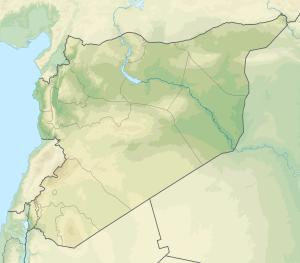تل الفخيرية | |
Tell Fekheriye, Syria | |
| Alternative name | Sikkan |
|---|---|
| Location | Ras al-Ayn, Al-Hasakah Governorate, Syria |
| Region | Upper Mesopotamia |
| Coordinates | 36°50′24″N 40°4′7″E / 36.84000°N 40.06861°E |
| Type | Settlement |
| Site notes | |
| Excavation dates | 1929, 1940, 1955, 2001, 2006-2010 |
| Archaeologists | Felix Langenegger, Hans Lehmann, Calvin W. McEwan, A. Pruß, Anton Moortgat |
| Condition | In ruins |
Exhibited in the Oriental Institute Museum, Chicago, USA.
Tell Fekheriye (Arabic: تل الفخيرية) (often spelled as Tell el-Fakhariya or Tell Fecheriye, among other variants) is an ancient site in the Khabur river basin in al-Hasakah Governorate of northern Syria.[1] It is securely identified as the site of Sikkan, attested since c. 2000 BC.[2] While under an Assyrian governor c. 1000 BC it was called Sikani.[3][4] Sikkan was part of the Syro-Hittite state of Bit Bahiani in the early 1st millennium BC. In the area, several mounds, called tells, can be found in close proximity: Tell Fekheriye, Ras al-Ayn, and 2.5 kilometers east of Tell Halaf, site of the Aramean and Neo-Assyrian city of Guzana. During the excavation, the Tell Fekheriye bilingual inscription (in the Assyrian dialect of Akkadian and Aramaic) was discovered at the site, which provides the source of information about Hadad-yith'i.[5]
In the early 20th century Tell Fekheriye was suggested as the site of Washukanni, the capital of Mitanni, but the claim is unconfirmed.[6][7] Many scholars opposed this theory including Michael Roaf, Peter Akkermans, David Oates, Joan Oates and Edward Lipiński.[2][8][9] However this identification received a new support by Stefano de Martino due to recent archaeological excavations by a German team led by Mirko Novák and Dominik Bonatz.[10]
- ^ L. Braidwood, Stone artifacts in C McEwan, Soundings at Tell Fakhariyah(Chicargo University Press, 1958 page 53-55.
- ^ a b Lipiński, Edward (2000). The Aramaeans: Their Ancient History, Culture, Religion. Peeters Publishers. p. 120. ISBN 978-90-429-0859-8.
- ^ Postgate, J. N. “The Land of Assur and the Yoke of Assur.” World Archaeology, vol. 23, no. 3, 1992
- ^ Gropp, Douglas M., and Theodore J. Lewis. “Notes on Some Problems in the Aramaic Text of the Hadd-Yithʿi Bilingual.” Bulletin of the American Schools of Oriental Research, no. 259, 1985, pp. 45–61
- ^ Dušek, Jan and Mynářová, Jana. "Tell Fekheriye Inscription: A Process of Authority on the Edge of the Assyrian Empire", The Process of Authority: The Dynamics in Transmission and Reception of Canonical Texts, edited by Jan Dušek and Jan Roskovec, Berlin, Boston: De Gruyter, pp. 9-40, 2016
- ^ K. Lawson Younger (2007). Ugarit at Seventy-Five. p. 146. ISBN 9781575061436.
- ^ Edward, Lipiński (2016). "Hurrians and Their Gods in Canaan". Rocznik Orientalistyczny/Yearbook of Oriental Studies.
- ^ D. T. Potts (2012). A Companion to the Archaeology of the Ancient Near East. p. 570. ISBN 9781444360776.
- ^ David Oates; Joan Oates; Helen McDonald (1997). Excavations at Tell Brak, Volume 1. p. 143. ISBN 9780951942055.
- ^ De Martino, Stefano, 2018. "Political and Cultural Relations between the Kingdom of Mittani and its Subordinated Polities in Syria and Southeast Anatolia", in Changing Faces of Kingship in Syria-Palestine 1500-500 BCE, Ugarit Verlag, p. 38: "...the recent German archaeological excavations at Tell Fekheriye support the assumption that the capital of Mittani, Wassukkanni, was located there..." See also Novák (2013: 346) and Bonatz (2014).


